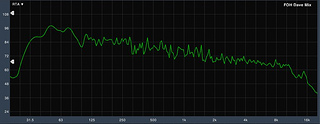
Frequency Disagreement
I meant to comment on something the other night while we were taping Church Tech Weekly, but I forgot to circle back and didn’t get a chance to. We were discussing PA tuning for a bit which was leaning more into PA voicing, although, some would debate they are one in the same. Regardless, one of the things Jason and Duke mentioned was that they often roll off high frequencies and especially the extreme high frequencies when they tune PA’s. I disagree with this idea, and here’s why.
First off, let’s define high frequencies. To me, I consider the the upper 2 octaves of human hearing to be high frequencies. These octaves center on 8k and 16k and range from about 5kHz up to 20kHz, although my 8 year old son is the only person I know who can hear anywhere close to 20kHz, and his hearing tops off around 18k.
While there can be some stuff in the 5-10k range that might need some care, in my experience, the stuff above 10k isn’t usually a problem. In my opinion, that’s actually where the money is and managing it properly is one of the things I believe separates the men from the boys.
But you know what, forget about my opinion on this for a minute. I think there is often some confusion about what the top end can really be in a mix so I urge you to check out this video from the Plugin Alliance guys on their Maag EQ plugin. In the video, the Maag’s legendary AIR BAND® is demonstrated on a high profile vocal, and I think it’s pretty clear what you can gain from those upper frequencies. The demo starts about 3:30 into the video and make sure to set YouTube’s quality to at least 480p. If you don’t hear it at first, wait until they bypass the plugin.
In my opinion, one of the big things you pay for in a top loudspeaker aside from durability, service and support, and overall quality, are, in my opinion, those upper frequencies. Low and mid-range boxes typically do a poor job with these or don’t even reproduce them at all. Our soon-to-be-replaced West Auditorium PA drops off at 12kHz; there’s just NOTHING above it, and that PA sounds like there’s a blanket over it which is one of several reasons why it’s due to be replaced next month.
I think I’ve written about this before, but it probably bears repeating. Our perception of distance is linked to high frequency content. Air naturally absorbs high frequencies over distance which leads our brains to perceive things as farther away as they get duller. Removing high frequency content pushes things back, and personally, as an audience member and a mixer I don’t like everything to sound far away.
Now, an excess of any frequency can be problematic. I’ve found over the years that balance is king. Too much lows without the mid and top is boomy and/or muddy. Too much mids and top without the lows gets harsh and bright. That’s basic mixing.
When it comes to high frequencies, though, physics is usually working against us. Loudspeakers seem to have a hard time generating them with enough power to push through the air’s natural absorption when they need to throw long distances. One of the advantages of vertical line arrays is that each loudspeaker covers a smaller slice of the listening area. There’s some debate on the practice, but high frequencies can be adjusted on a per cabinet basis to extend the throw to cover the entire listening area. Traditional conventional boxes, however, will naturally have limited high frequency throw due to the inverse-square law coupled with air absorption.
So here’s my point. I don’t think you should roll off the high frequencies in a PA because if they are there to begin with, they fall off naturally if you don’t do anything to boost them. If anything, you probably want to preserve these when possible because they can be very nice in a mix when properly balanced.


 Next Post
Next Post



“Traditional conventional boxes, however, will naturally have limited high frequency throw due to the inverse-square law coupled with air absorption.”
Doesn’t the inverse-square-law apply equally to the HF section of line arrays too? My understanding is that they don’t exhibit line array behaviour at higher frequencies because the emitters can’t be placed close enough together to sum coherently at the shorter wavelengths involved. Because of this they are designed with each box having very tightly controlled vertical HF dispersion so that they don’t interact.
This WILL mean that thay can be louder on axis, because “on axis” is a much smaller area so the energy isn’t as dispersed. Another way to look at it is that it has travelled much farther before it has become as widely dispersed.
I may be worng, this is just my understanding of it.
My opinion on the PA tuning thing is that if the PA isn’t changing anything about your mix and you don’t like what you’re hearing then it’s your mix you don’t like, not the PA tuning. If I’m sending something out of my mixing console, it should be because I want the audience to hear it.
I think some people get “high frequency” confused with “2K-4K hurt range” and end up cutting the wrong thing. As you say, it should be balanced.
And there’s nothing at all wrong with 2K-4K either as long as there’s not too much. 🙂
It’s only sort of related, but I like to feed the PA from a matrix and do any PA-specific EQ there. This leaves the LR mix “pristine”, I can record it, send it to other rooms etc. and it won’t have any EQ on it that is only there because of the PA. Each “zone” get’s it own matrix with it’s own EQ and level control.
Chris
Inverse-square law applies to everything. The summing/coupling behavior of speaker arrays can give the perception that it doesn’t apply, but it does. We can’t break the laws of physics.
I think there’s a little bit of debate, though, on how line arrays behave at those high frequencies. Personally, I like the L-Acoustics stuff on Wavefront Sculpture Technology. Regardless of the research, though, I’ve heard interaction at higher frequencies while standing in the lower zone of an array and adjusting high frequencies boosts in an upper zone. That’s why there’s debate on whether you can make HF adjustments on different zones or cabinets within a line array. Some people don’t mind, and then some do. Sometimes it’s all a compromise.